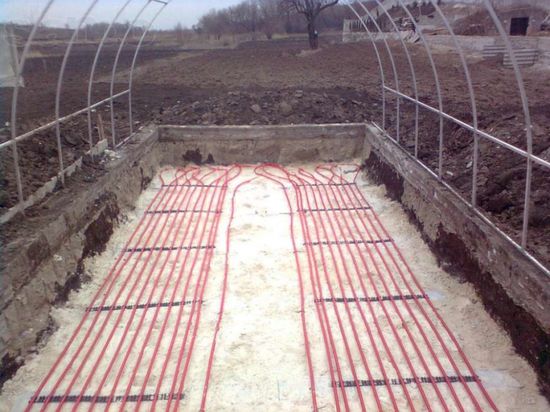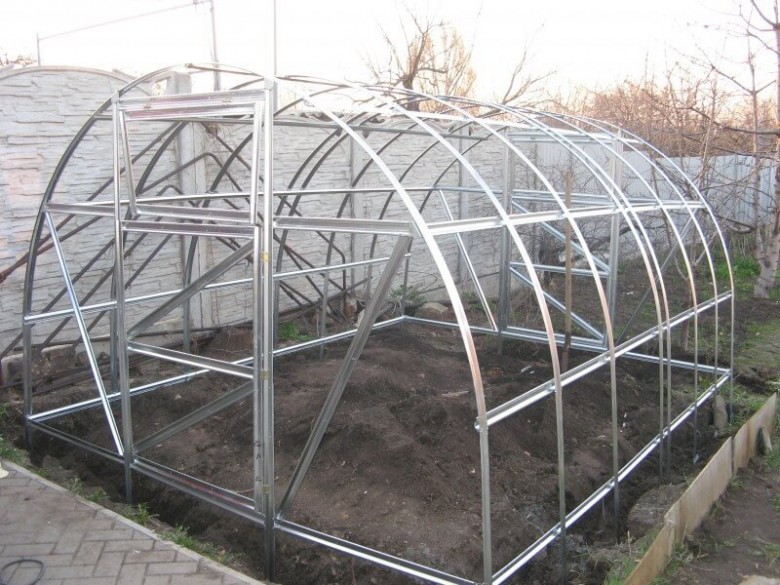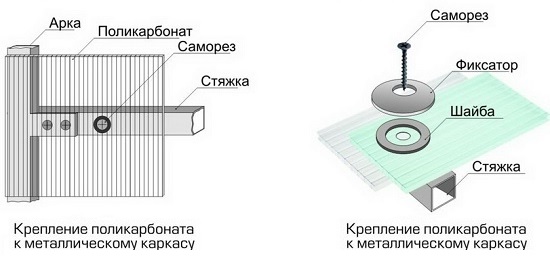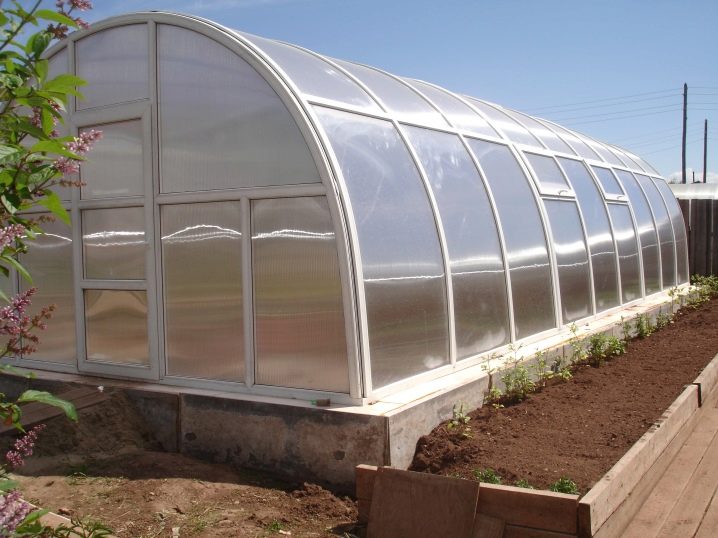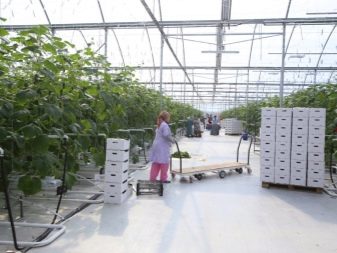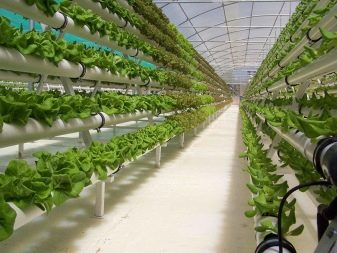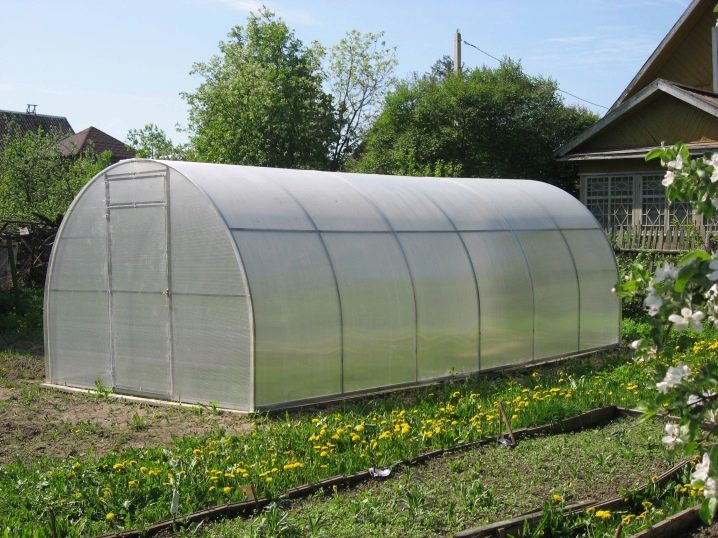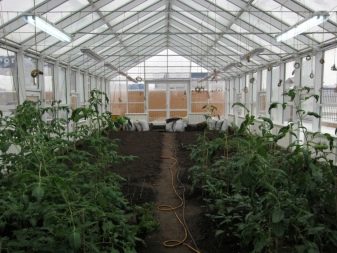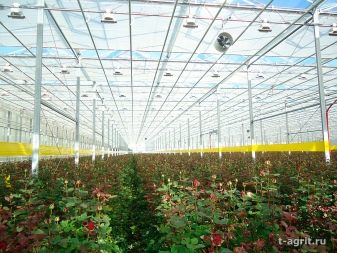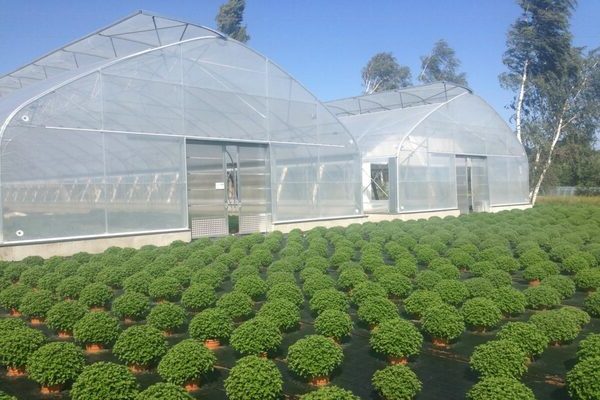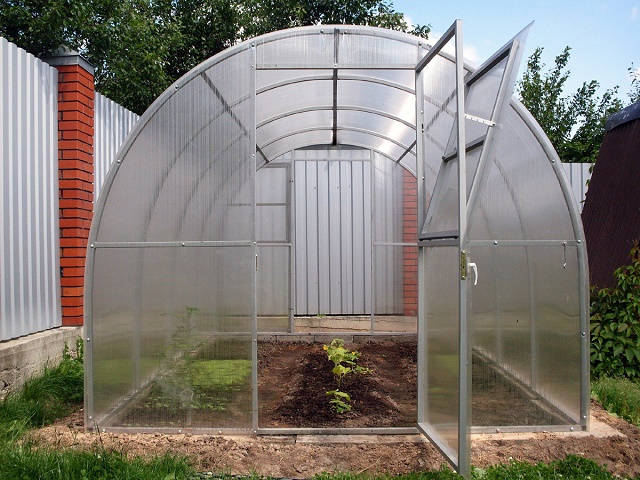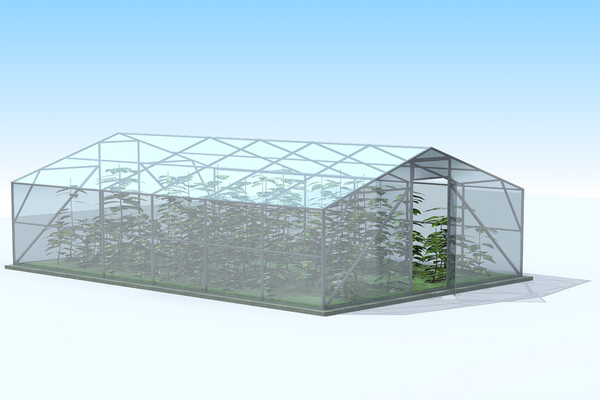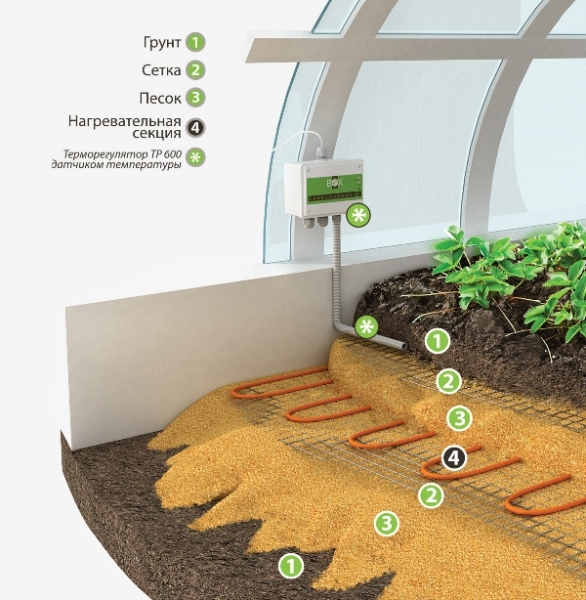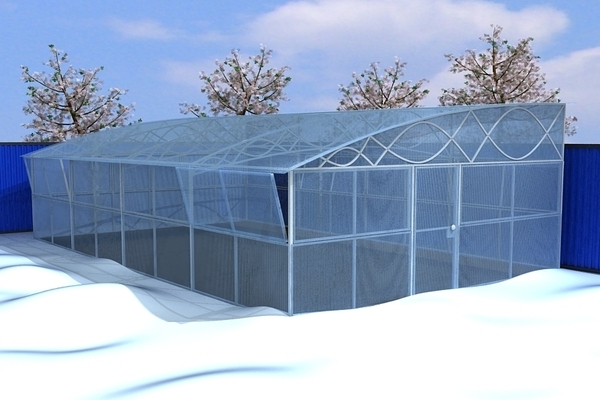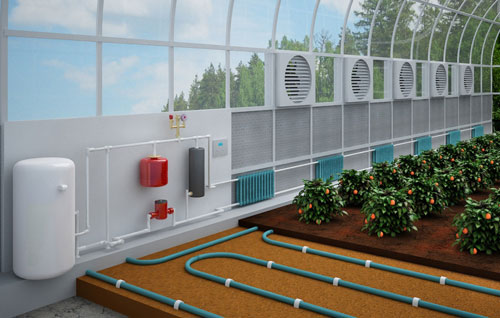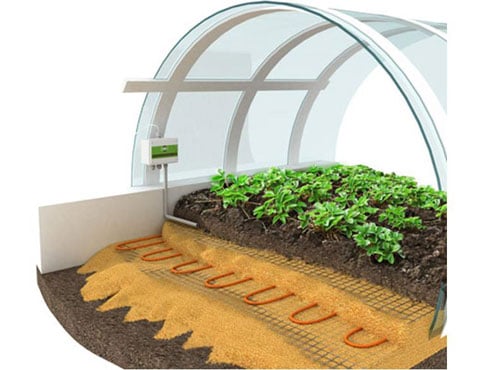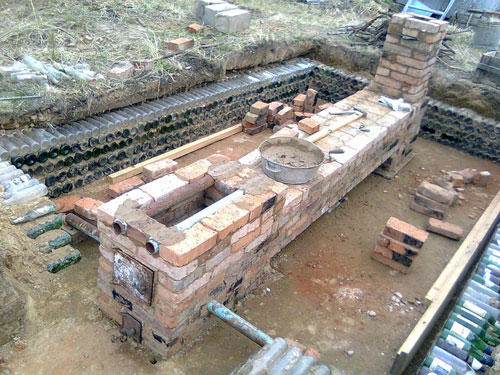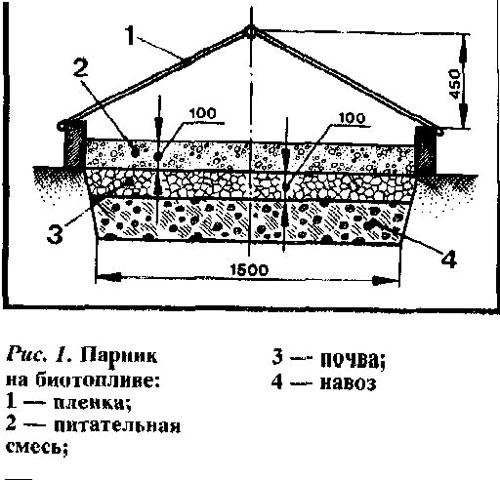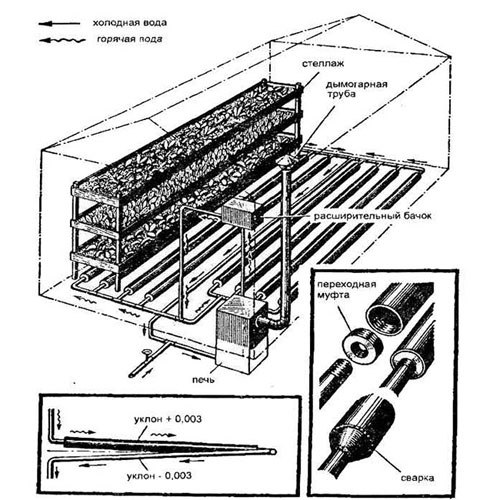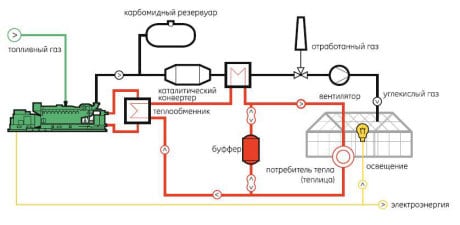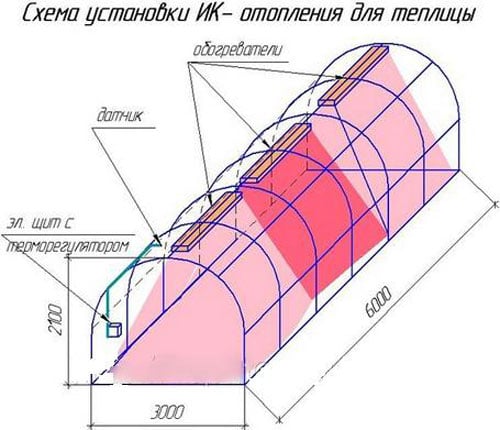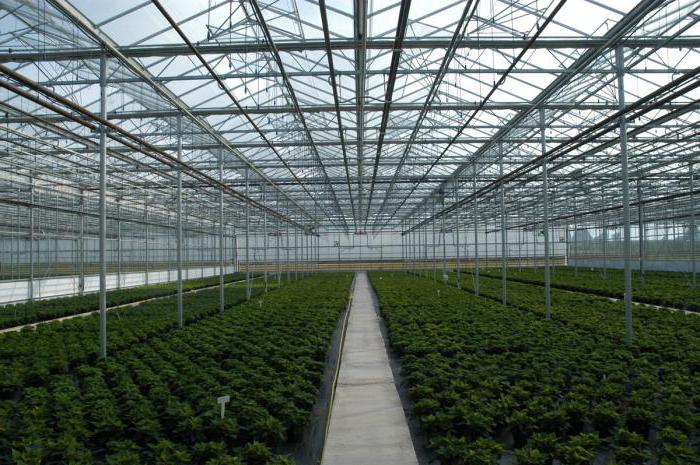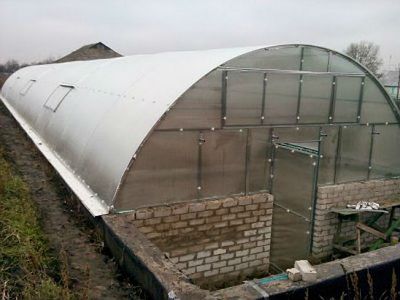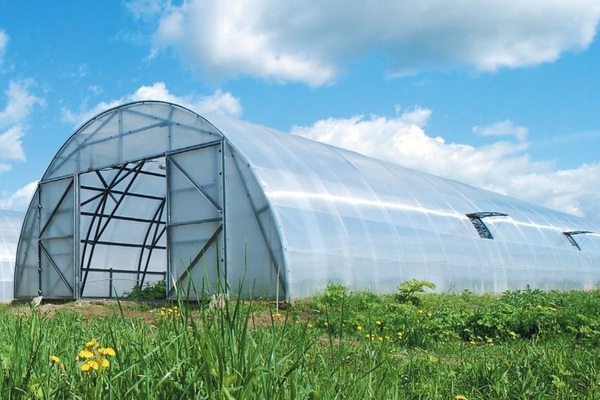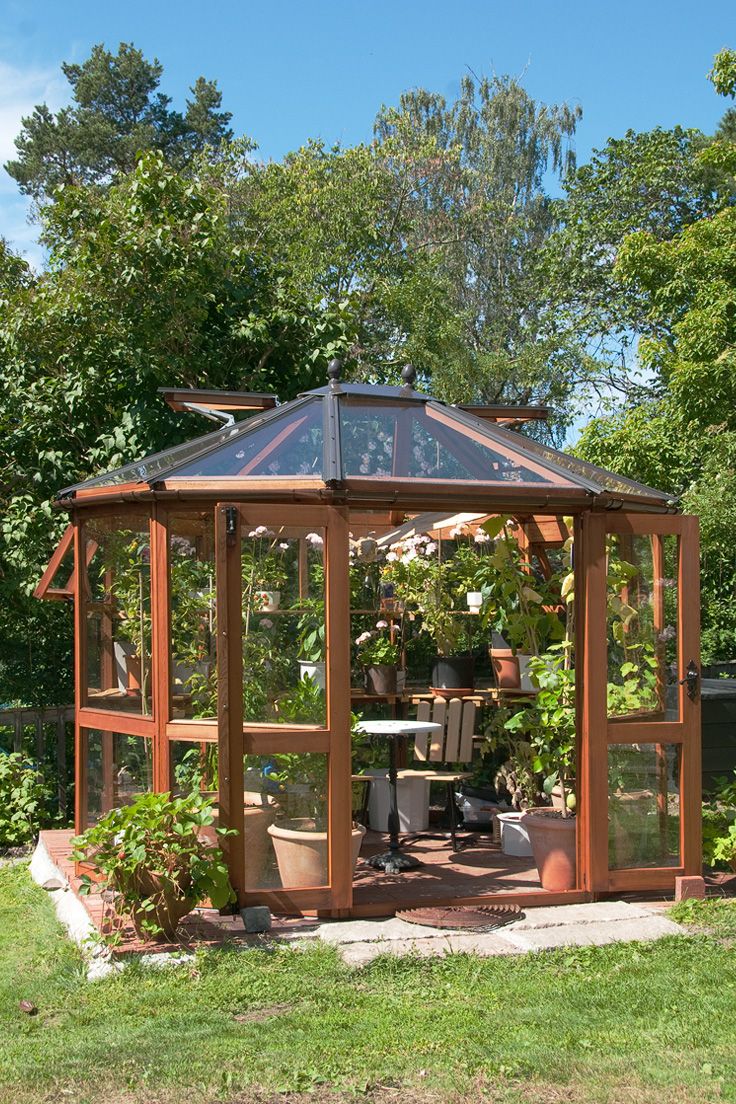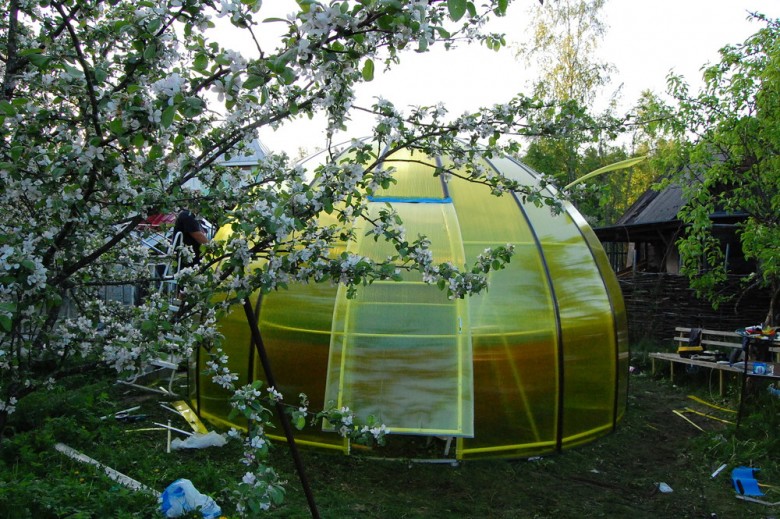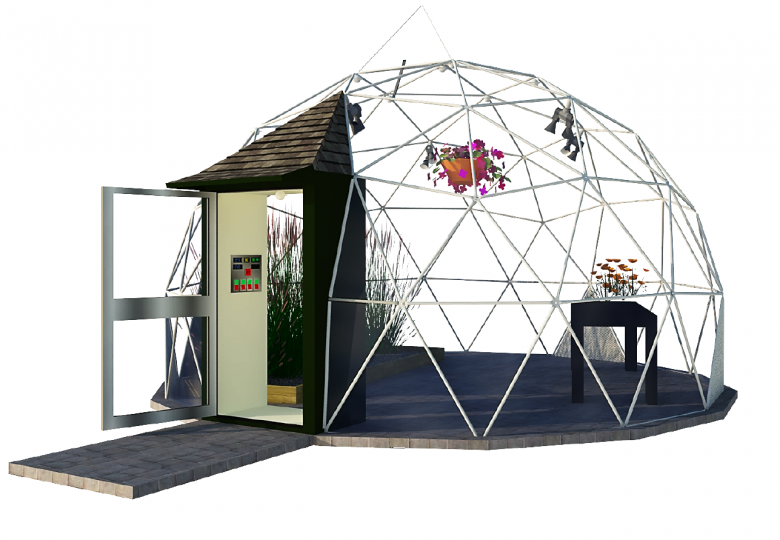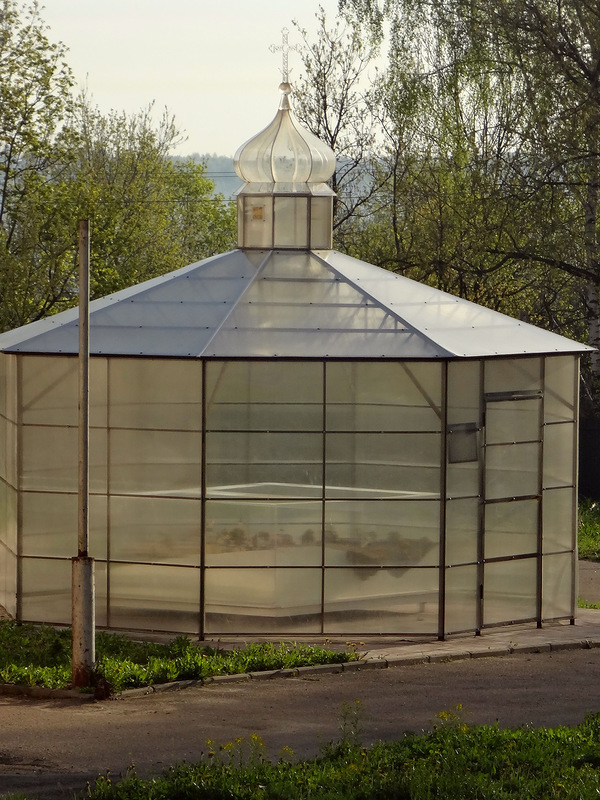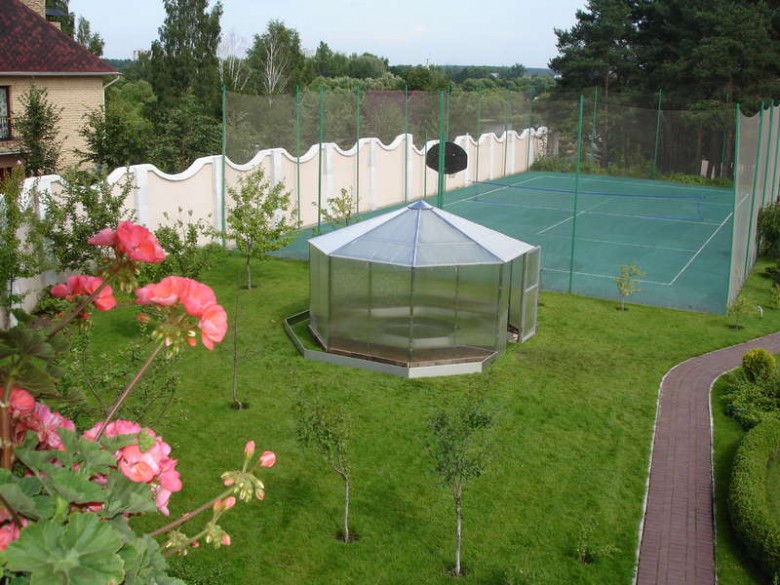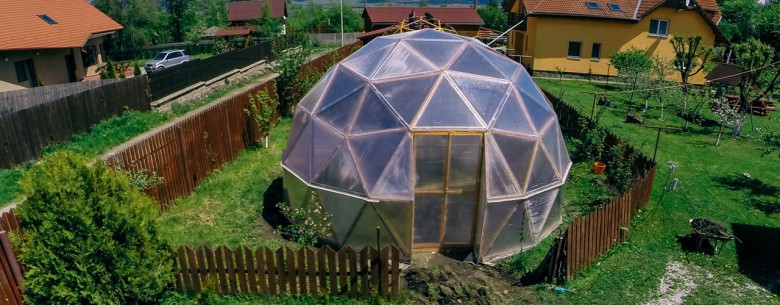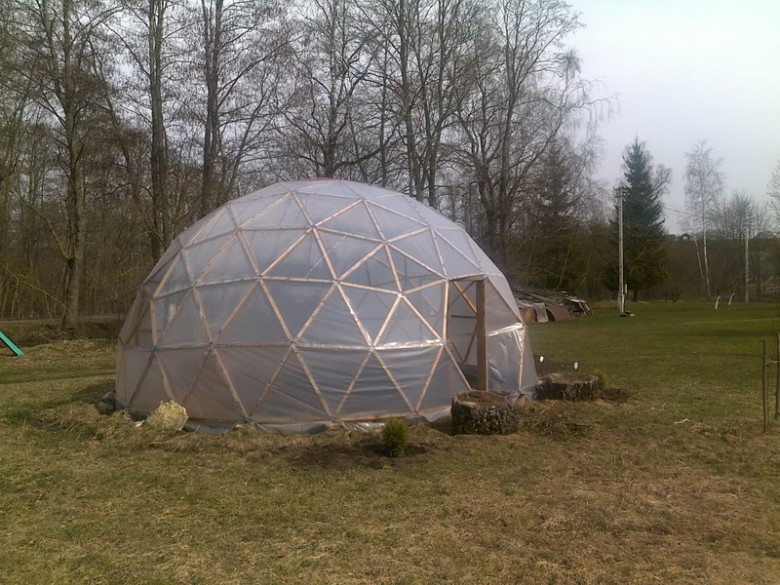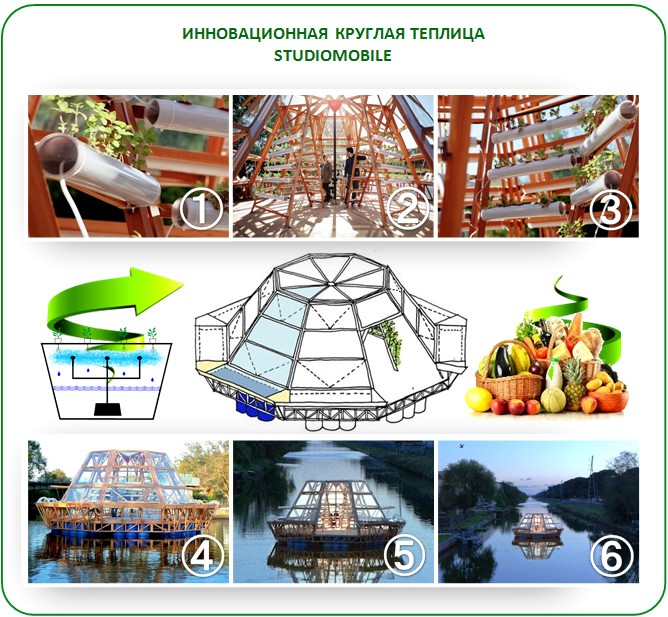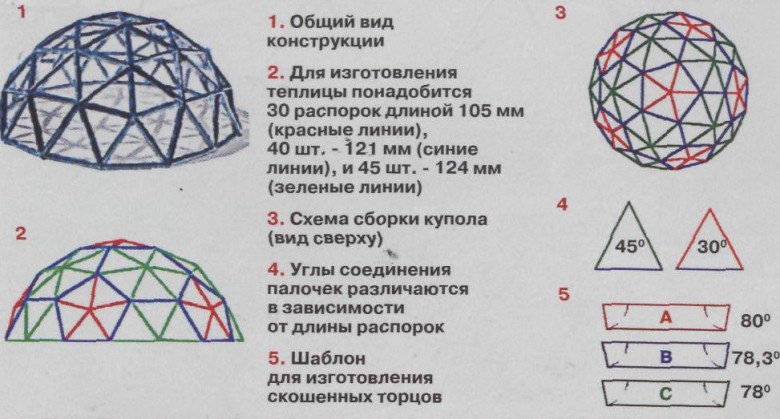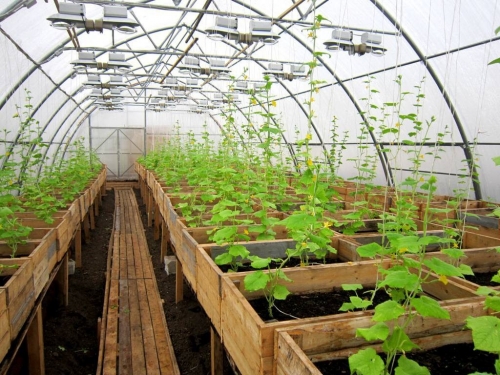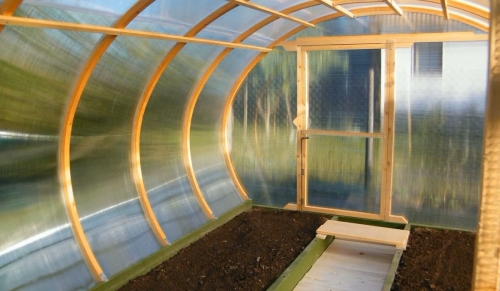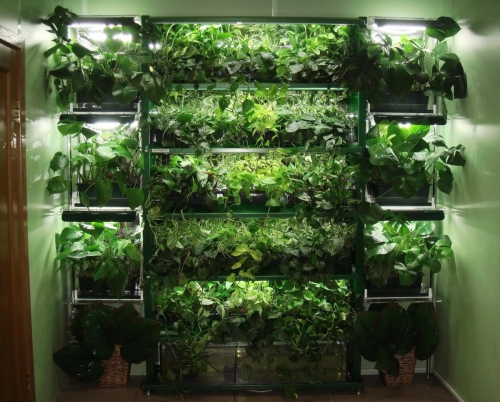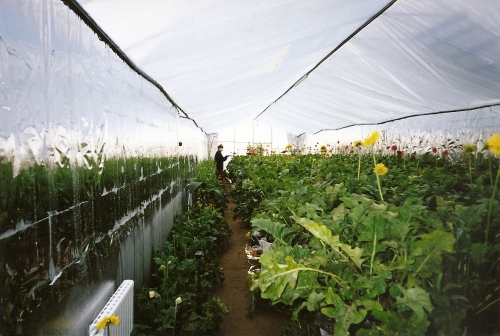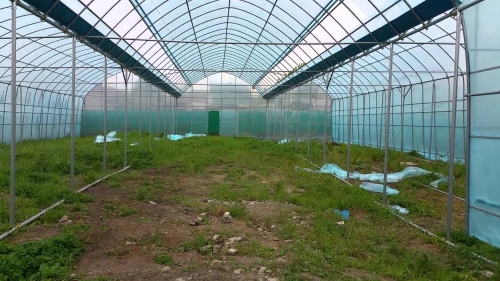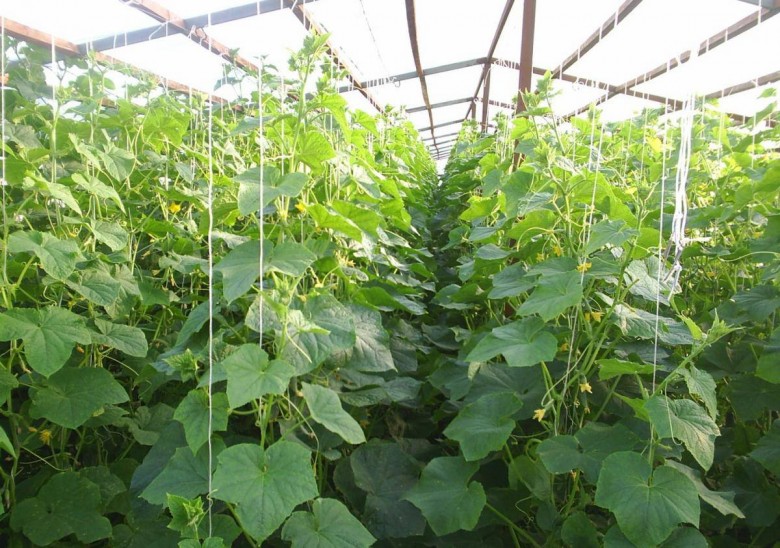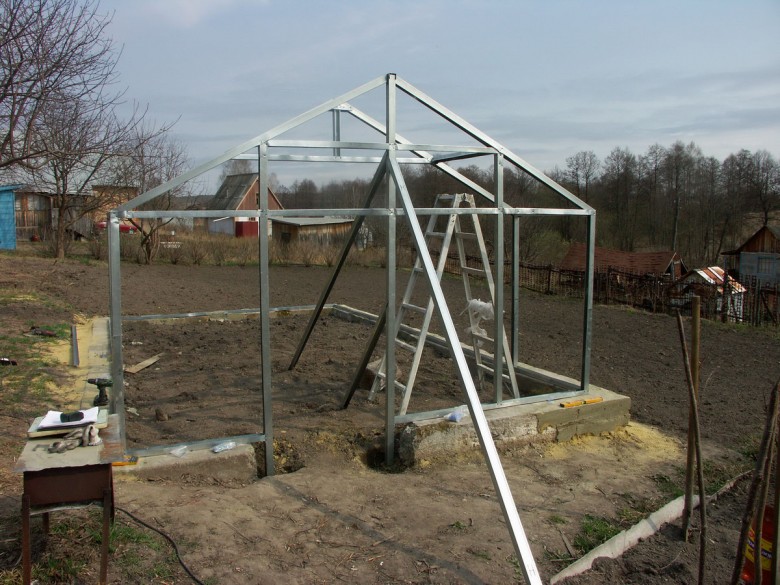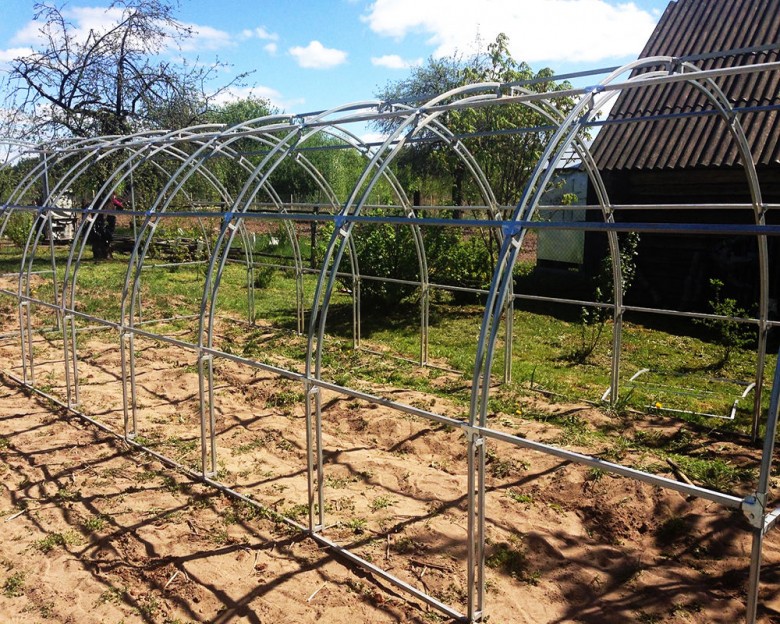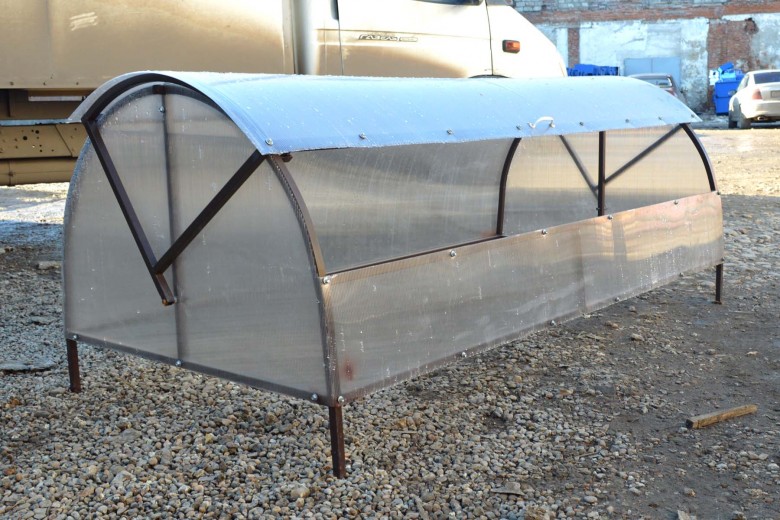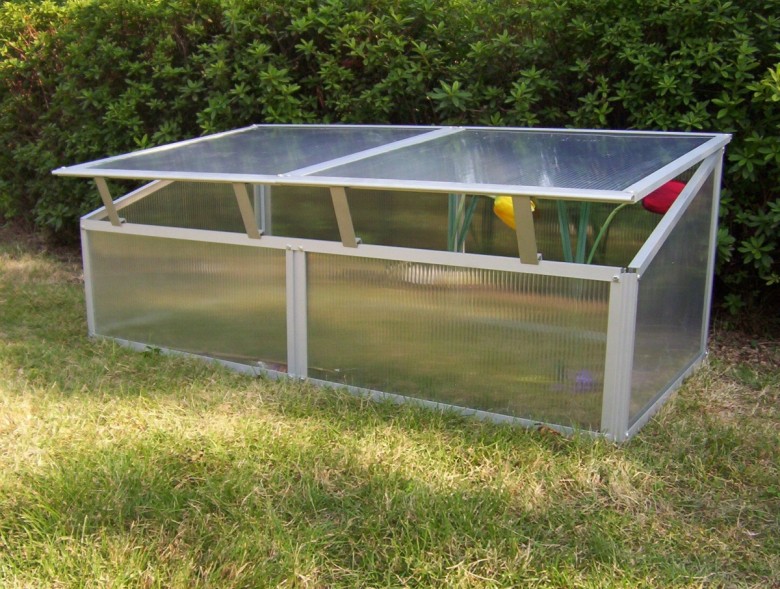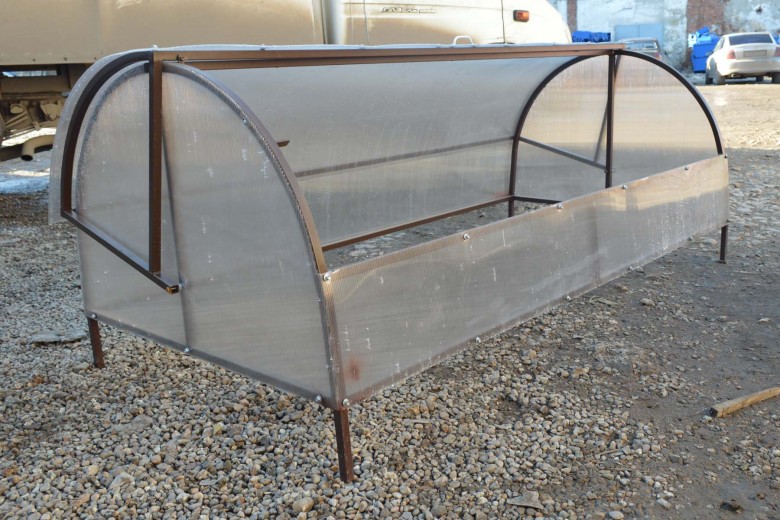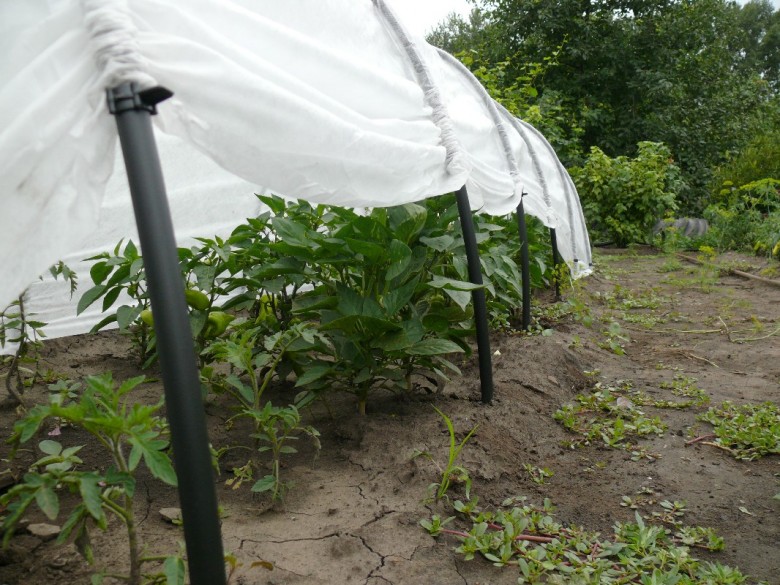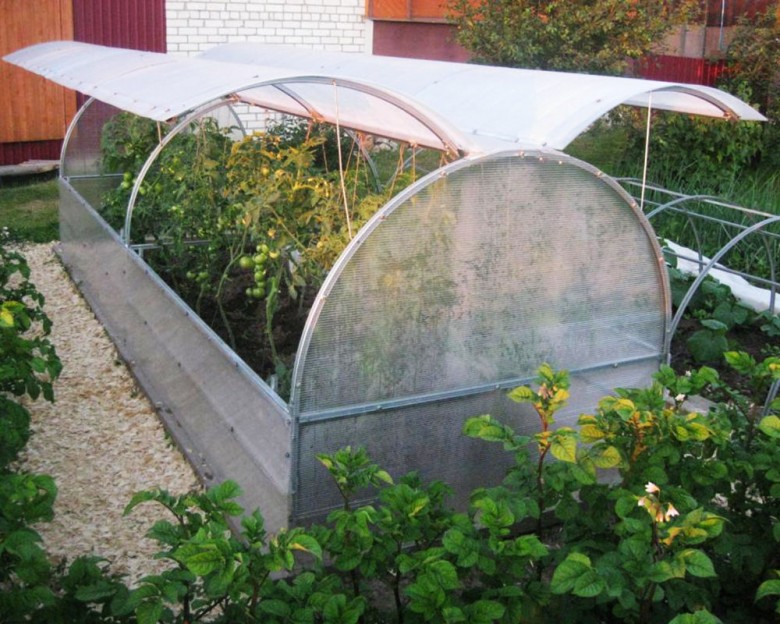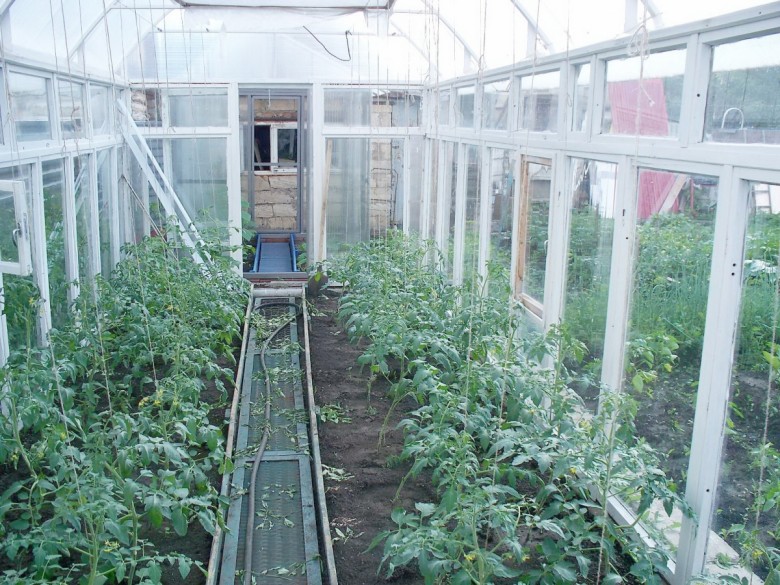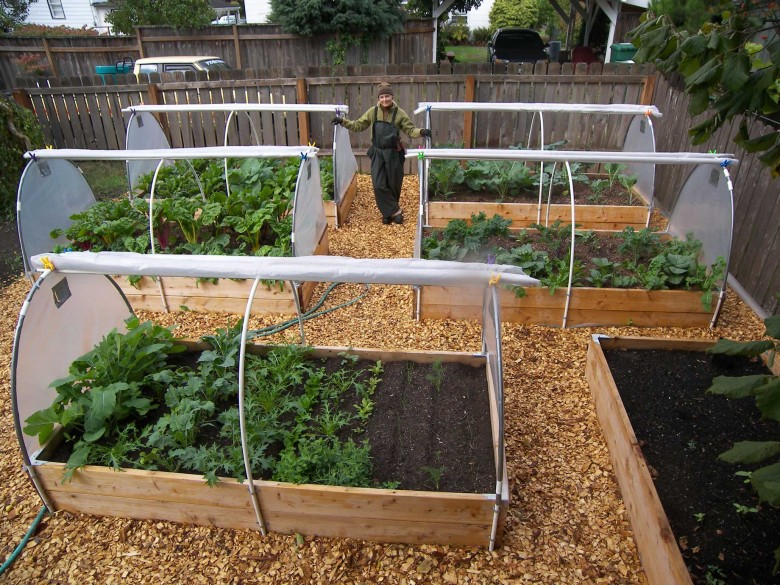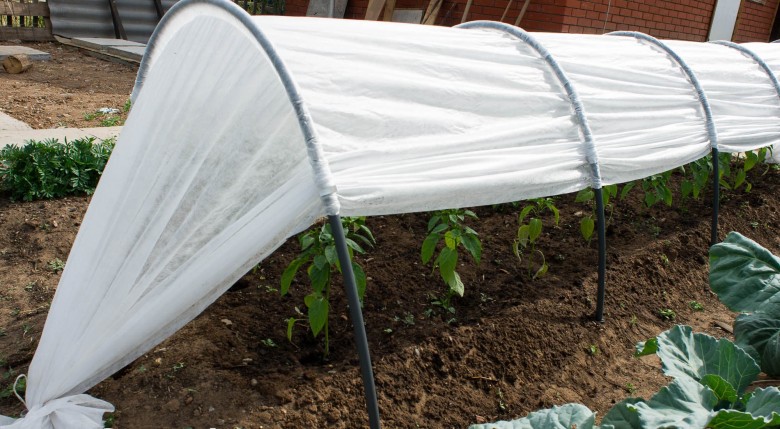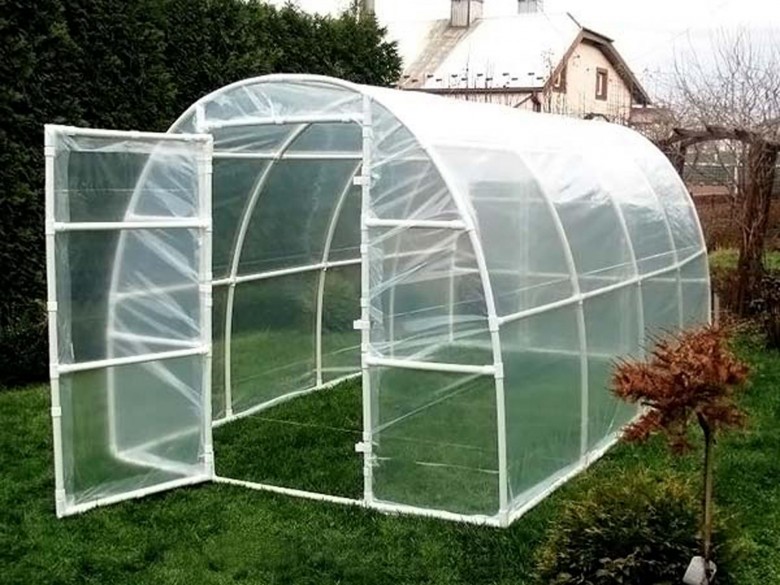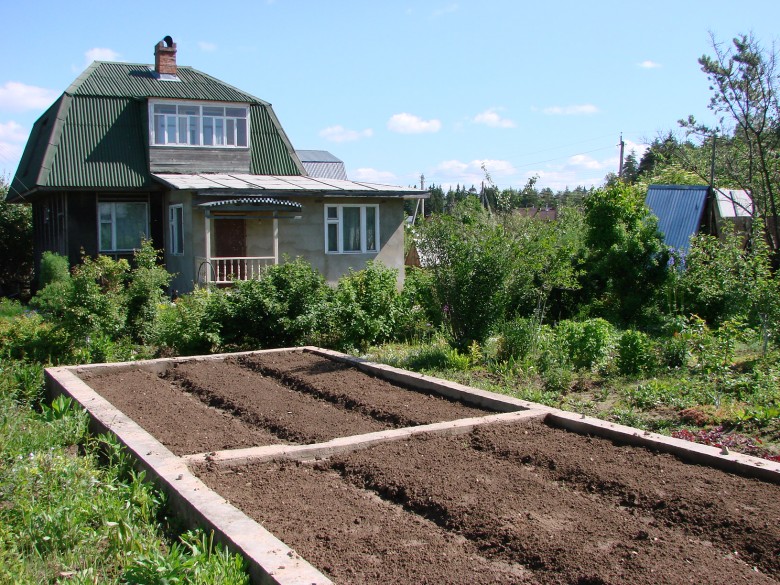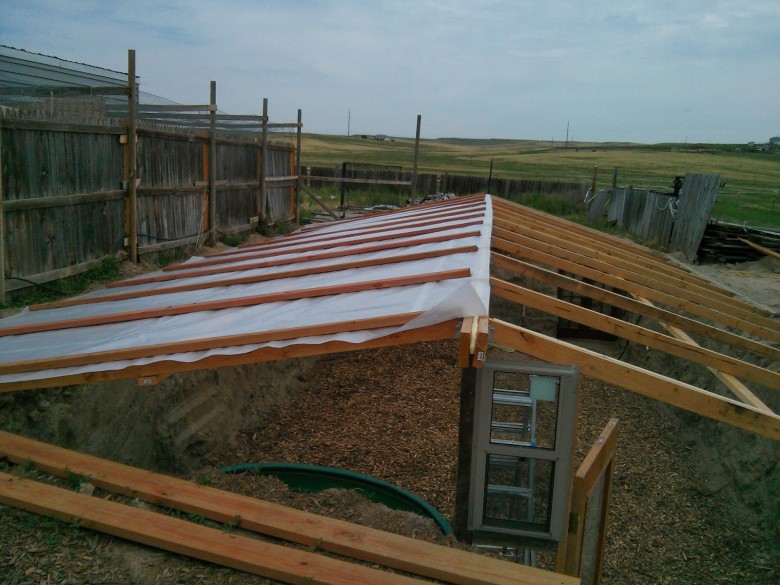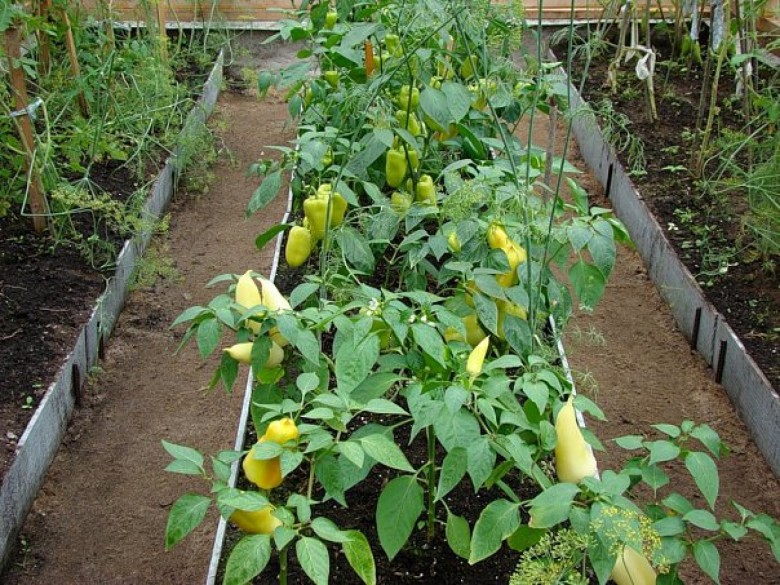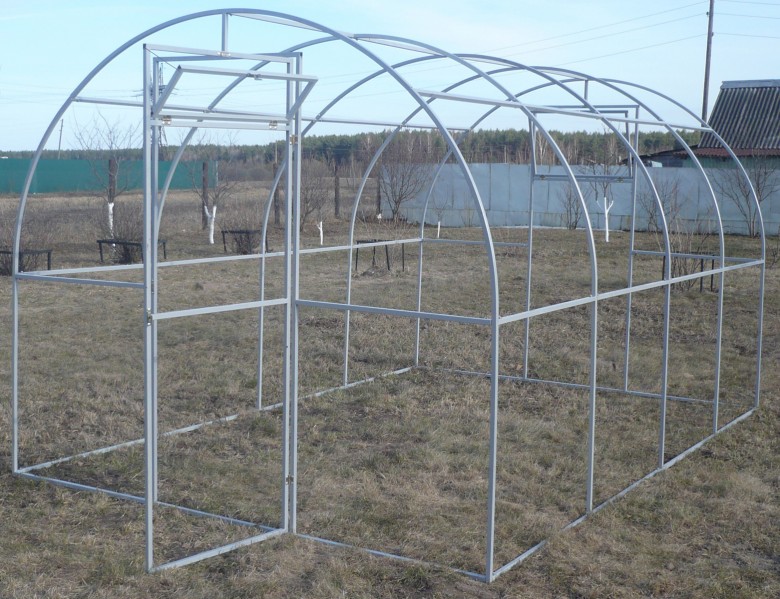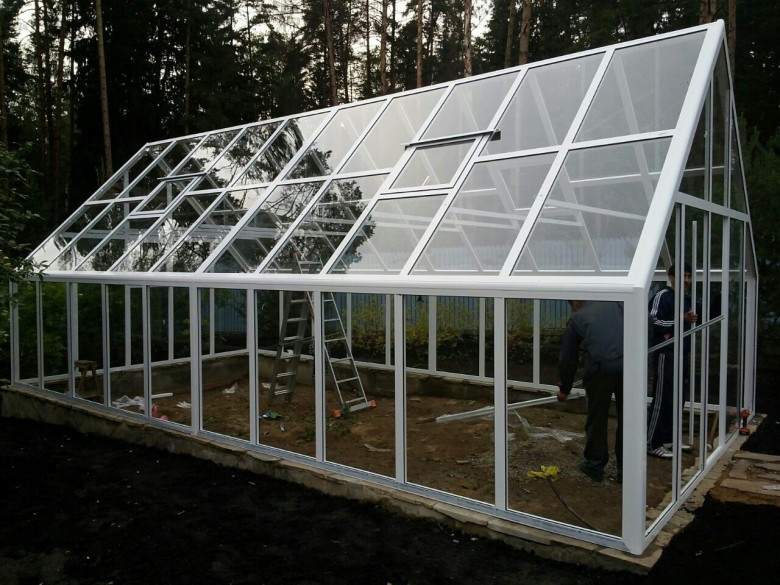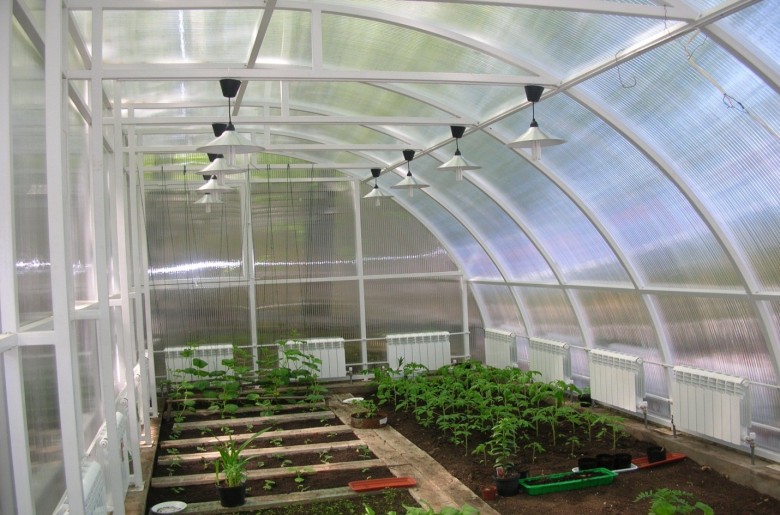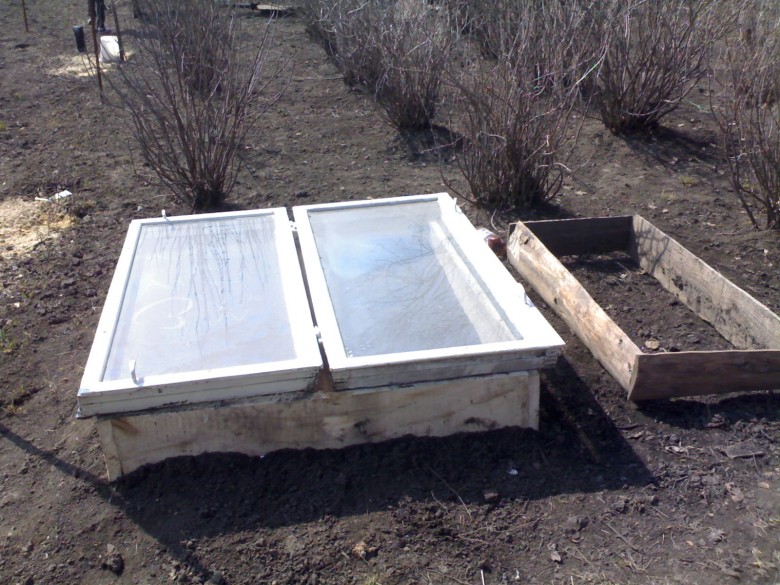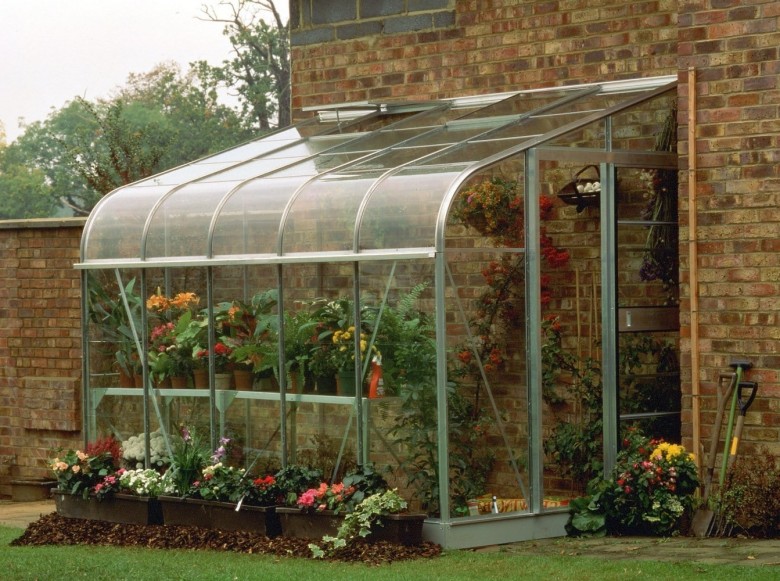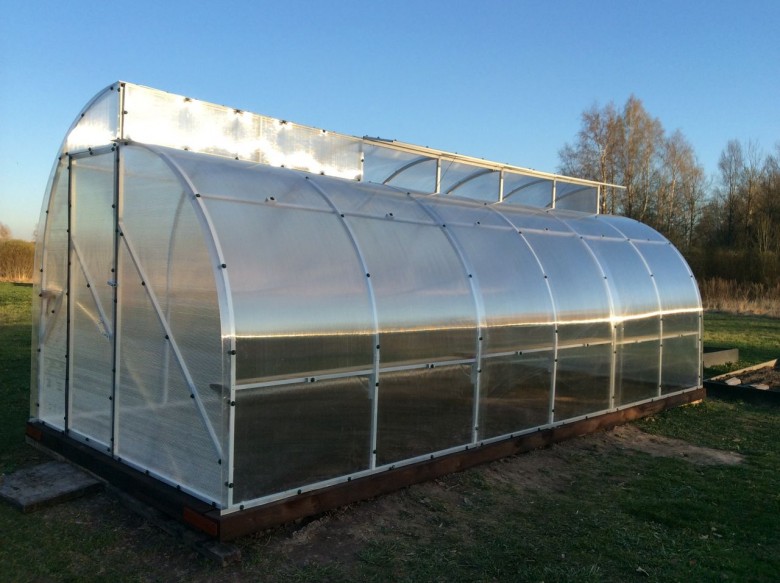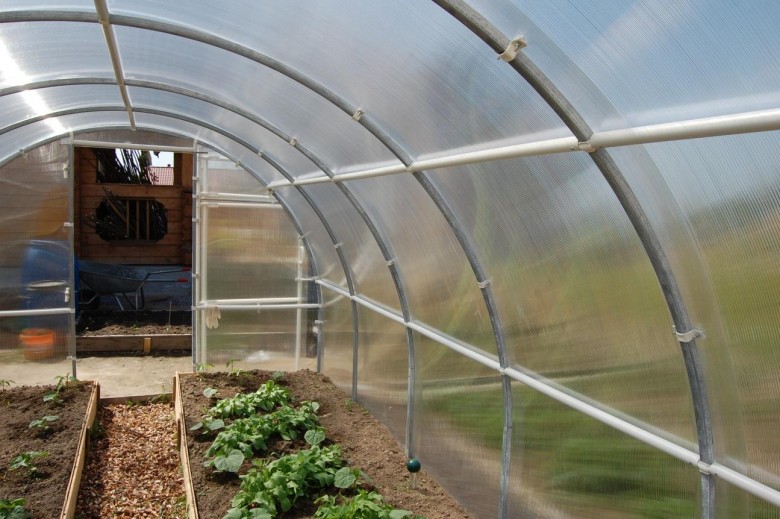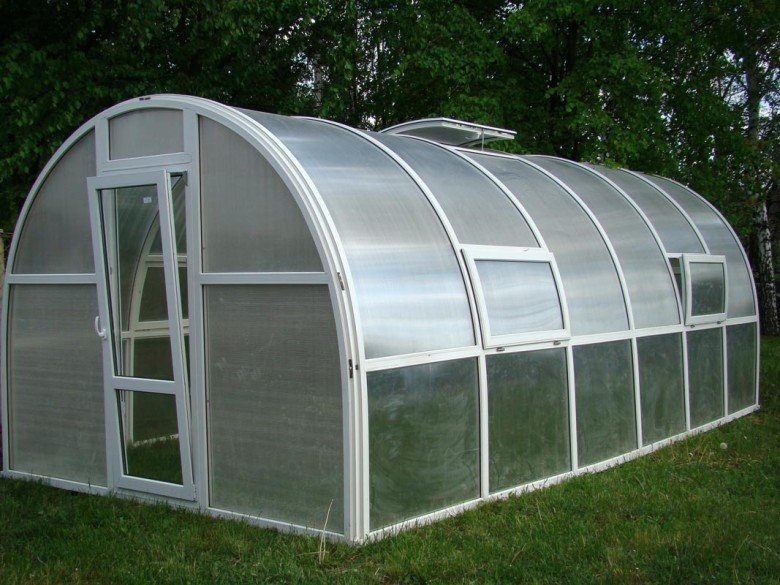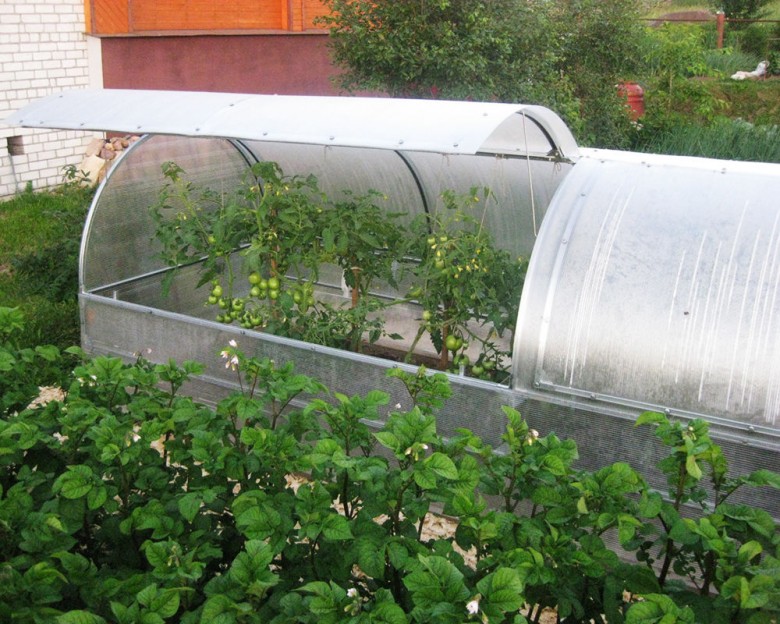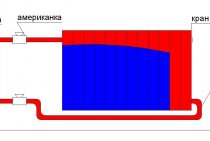Metal profile frame
First, arched arcs are installed from one end of the polycarbonate winter greenhouse to the opposite wall. Each part is leveled and attached to the base beam.
Then the upper and lower guides are screwed or welded to the arcs. This creates strength and stability of the structure.
Fix the polycarbonate with thermal washers and self-tapping screws. Fittings should not be tightened too much, polycarbonate sheets should not sag.
There is an easy way to attach a polycarbonate sheet to the end of a future greenhouse. It is necessary to cut a square with sides equal in length to the bottom of the greenhouse. Then attach the sheet to the end and carefully cut off the excess polycarbonate at the edges.
The idea of an eco-greenhouse and its device
Now let's move on to the description of the eco-greenhouse and find out which of the ideas of permaculture it intersects with. The main feature of the building is that it is combined with a chicken coop. These birds are distinguished by a very high body temperature of + 40 ° C. And if you equip them with a separate room for living and connect it with ventilation to a greenhouse, then warm air with a high content of carbon dioxide and ammonia will enter the latter, which will positively affect the condition of the plants.
 Eco-greenhouse features
Eco-greenhouse features
Additional heating of the eco-greenhouse is carried out using thermal accumulators. In the simplest version, these are containers with water or stones placed in the same room with plants under the rays of the sun penetrating through polycarbonate, glass or film. During the day, the battery heats up and stores energy. At night, when the sun goes down and the temperature outside decreases, these stones or water give off heat and thus warm the soil and the crops that grow on it.

In addition to producing heat and carbon dioxide, chickens in eco-greenhouses perform other tasks:
- production of eggs and their shells - a natural fertilizer;
- production of manure - one of the components of compost;
- outdoor pest control - chickens eat insects;
- natural processing of open ground - chickens rake it in search of food.
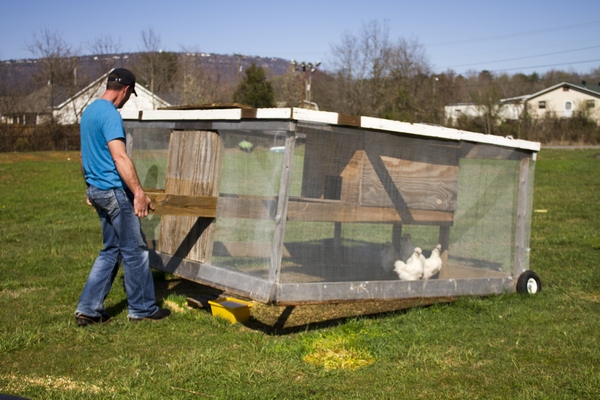
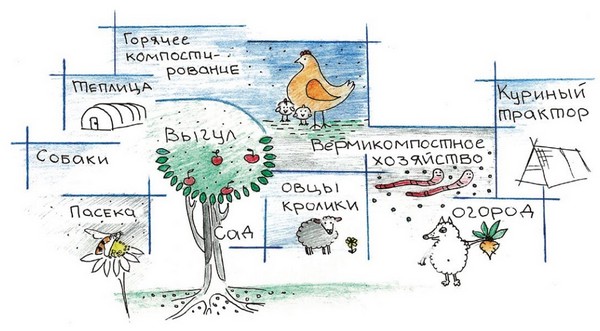
Compost produced using chicken manure also finds its way into the eco-greenhouse as fertilizer for the garden bed and another natural source of heat for the soil. As for water, in such greenhouses it enters the plants through drip hoses. At the same time, it partially accumulates due to precipitation in open containers equipped with filters.
Pros and cons
Before starting construction, a scheme for construction should be developed. If you plan to grow a winter garden, then you need a certain temperature regime, thanks to which it will be possible to grow tropical plants. For any structure, if it is created by oneself, a solid foundation and a reliable frame are required.
Greenhouses designed for use all year round have their advantages and disadvantages:
- in a trench greenhouse, vegetables and fruits are grown all year round;
- the underground structure is characterized by a cool temperature on a hot day, which is necessary for most plants;
- these types of structures can be done independently using a diagram or drawing;
- have a low cost - during construction, you can use budget building and finishing materials.
Hangar models covered with polycarbonate are especially popular - this is evidenced by the reviews of the owners.
Such greenhouses have many advantages:
- low cost;
- ease of assembly;
- excellent protection from snow and rain;
- plants receive the maximum amount of light.
Polycarbonate for building a greenhouse has excellent thermal insulation properties, it is very flexible, which allows it to be used for an arched greenhouse. Polycarbonate is a very light material - it is 16 times lighter than glass.
Can be used for construction and metal-plastic. Although the independent construction of a metal-plastic greenhouse is not an easy task, they usually resort to the services of specialists for this. For such structures, it is better to make the frame to order - as a result, it may not be a very profitable building financially.
block greenhouse
Year-round greenhouse
A modular year-round greenhouse is built as nearby gable or arched structures that are in contact with each other on the sides. At the junction, it is necessary to make several support posts that can replace the wall. As a result, it is possible to reduce the financial costs of building a greenhouse, but at the same time make a very effective and functional structure that will last for a long time if it is assembled correctly. The roof can also consist of not one, but several sections. Several gutters are also made in it in order to drain water that can accumulate during heavy rainfall.
The size of greenhouses, their length can be absolutely any, and it all depends on how much planting the gardener will carry out in the greenhouse, and for what purposes they do it - for personal cultivation of crops, or for more extensive industrial production of goods. You can cover the greenhouse with the good old and well-known polycarbonate or glass. Film or any other agronomic material can also be used - it all depends on the degree of material security of the gardener and on what materials will be most available to him in a particular period of time.
Block greenhouses have a number of advantages over any other types of greenhouses. These benefits include:
- the design turns out to be the most financially economical when compared with any other types of greenhouse buildings - at the same time, this is a very durable greenhouse that reliably protects plants from increased wind and drafts, but at the same time warms them up to the most comfortable temperatures. In addition, the greenhouse is very resistant to snow loads, it is not afraid of any precipitation - all parts of the greenhouse are well lit, which is also an undoubted advantage of this design in comparison with other types of greenhouses - it is very easy to place an irrigation and heating system inside, and you can additionally put another lighting system so that the plants are illuminated not only during the day under natural rays, but also at night - if you make windows in the greenhouses, then everything inside will be perfectly ventilated through them. Also, vents can be placed not in the walls, but on the slopes of the greenhouse roof.
There are also disadvantages to this design.
Due to the fact that inside it is necessary to make a large number of technological paths that are necessary for the gardener, there are not so many useful areas in the greenhouse that you should pay attention to when designing. The second drawback is that in some places the roof will deepen, snow or any other precipitation may accumulate there, and they will need to be removed from there on their own.
It will be possible to install heating, but this will require additional funding for this building, which is worth paying attention to.In general, such greenhouses are mostly used for growing plants on an industrial scale, and therefore they are rarely installed on private land. In addition, it is simply economically unprofitable for a gardener to install a block-type greenhouse on the site for private cultivation of plants, so he needs to choose from the other types of greenhouses mentioned above.
Peculiarities
For many summer residents, greenhouses are familiar, inside which temperature drops are felt. For greenhouses that are located in the ground, these disadvantages do not exist. In such buildings, the walls work like a thermos, so you can not spend a lot of money on heating and electricity. A thermos greenhouse allows you to get a year-round harvest of fresh juicy vegetables and herbs.
Underground structures are suitable for growing annuals and perennials. In the greenhouse, you can plant small decorative and exotic trees and shrubs, and you can also start the production of roses or other flowers here. Such a year-round greenhouse will allow you to regularly collect vegetables, fruits, herbs and citrus fruits, not only for your own use - gardening products can be sold on the market, thereby creating your own small business.
Final works
Greenhouses for year-round use require a truss system that is nailed to a support. The jumpers can then be removed. A ridge beam should be mounted under the rafters. Now the front supports are brought under it. Their size is 880 millimeters. Greenhouses for year-round use with heating require the installation of a furnace at the last stage, which is preferable to be located in the vestibule.
- Year-round greenhouse - myth or reality
- Installation of transparent greenhouses for year-round use
- Installation of a polycarbonate greenhouse
- Construction of a year-round mixed greenhouse
- Heating systems for greenhouses
- Additional greenhouse lighting
Important Rules
Greenhouses are not installed in dark places with minimal sunlight. Plants for rapid growth and development will need the maximum amount of solar heat. With strong heating, the roof of the structure is shaded by improvised methods, for example, painted over with lime. White color will repel excess ultraviolet, but the plants will not be deprived of light.
Place to pass
Like every structure, the greenhouse will need minor cosmetic repairs or serious finishing during use. The owner must have free access to it in order to quickly deliver the necessary building material or irrigation equipment. After a certain amount of time in the greenhouse, it is required to change the earth. Her transportation should not be difficult.
The optimal dimensions of the structure are selected depending on the area of \u200b\u200bthe site, the amount of the intended crop and the season. For summer greenhouses, small removable structures are suitable, which perform more functions in the spring. In the hot period, they are disbanded, removing the roof and walls, and by winter they are removed to an outbuilding. For the winter greenhouse, large stationary frames are installed. Such models will withstand any adverse precipitation and protect the crop from frosty winds.
Do-it-yourself gable year-round greenhouse
Year-round greenhouse
The second type of greenhouse is a gable. In fact, this is not one year-round greenhouse, but two, which are oriented in two cardinal directions - to the south and to the north. On the north side, it is recommended to install an insulated vestibule, and there may also be the most ordinary blank wall that will protect the greenhouse from cold winds, drafts or possible frosts. The dimensions of the greenhouse depend on what planting areas the gardener plans to place inside, as well as on how he sees it in principle.The width can vary from five to twelve meters, sometimes more, the length can also be any. The slopes have an angle of 25 to 35 degrees, again it all depends on the design and on the project, which is prepared in advance by gardeners and designers.
Despite the fact that the design seems very simple, at the same time it is particularly durable. The frame is recommended to be made on a metal base, and if these are small greenhouses, then a tree will do. The slopes rest against the racks, which are located in several rows, which makes the greenhouse even more solid and durable. In order to cover the slopes, you can take stationary glazing or frame glazing. Polycarbonate may also be suitable for these purposes, but its thickness must be at least six centimeters so that it can withstand this design and not collapse. In the roof, as well as in several places in the wall, it is necessary to make a ventilation system so that it is not stuffy in the greenhouse, mustiness does not form and, accordingly, various bacteria do not develop that will provoke diseases.
Gable greenhouses have, of course, their special advantages. Among them stand out such as:
- gable greenhouses are ideal for use in private households, as well as on small farmsteads, as they are quite miniature and compact - the size of the greenhouse can vary depending on the interests and needs of the gardener. In general, it can be 30 square meters, or maybe ten times more - everything is determined by the guidelines and desires of the gardener himself in the construction of this structure - due to the fact that the greenhouse perfectly combines a convenient width and height, heat losses in such greenhouses are reduced to minimum. Here we should say thanks to a convenient and really very versatile design.
Of course, it is worth paying attention to the fact that in gable greenhouses, if it is of a suitable area, then some mechanisms can be organized there, thanks to which the greenhouse can even sometimes transform, change its size, and its purpose. This is, of course, a small disadvantage.
Another disadvantage is that the ramp has a very small angle of inclination. Because of this, precipitation in the form of snow can accumulate in it, and therefore the gardener will need to independently clean the greenhouse from snow drifts. In general, such a greenhouse design is in great demand today, and it can be found on the territory of various personal plots.
Greenhouse heating
One of the most important points in the construction of a greenhouse is heating. This statement is quite reasonable, since plants, as you know, cannot grow or produce crops without heat. Unfortunately, it is not always possible to conduct heating in the greenhouse from the house itself. However, there are other methods of supplying a greenhouse with heating. The most common and convenient are electric radiators, infrared radiation, convectors, heaters.
Infrared devices will be a fairly economical and effective option. They not only provide plants with warmth, but also provide light, which is also necessary for the growth of vegetable crops. It will be wise to place infrared equipment under the ridge so that light and heat are evenly distributed throughout the space in the greenhouse.
Shed greenhouse for year-round cultivation
Greenhouse for year-round cultivation
Let's start with a description of a shed greenhouse. This year-round greenhouse is the simplest in its design, and it is intended not for seasonal, but for year-round use. It consists of a blank wall, which is located at the back and faces the southern part, as well as a glazed slope, which faces all other cardinal points (it is recommended that the plants receive enough light and sunlight and do not suffer from its lack). The wall, which is located behind and is deaf, is recommended to be built either from brick or from concrete. At the same time, these structures can also retain heat in the greenhouse, which, of course, is an undoubted advantage.Shed greenhouses look very decorative and not at all cumbersome, they can also be built not separately, but made in the form of extensions to the main house or to another outbuilding that is already located on the site. Then the gardener will save not only building material, but also his own time, and this plays a significant role, taking into account the modern rhythm.
As for the frame, it is usually made of wooden beams. The slope can be either straight or slightly curved, everything here depends solely on the wishes of the gardener himself. Instead of glass, you can use polycarbonate or durable reinforced film - it all depends on the level of the budget.
There are also many advantages that a single-slope year-round greenhouse has, and we cannot simply ignore them:
- this is a fairly budgetary design, its construction will not require too much finance - the greenhouse retains heat perfectly, especially considering that it can be wall-mounted - this is also one of its undoubted advantages - the main wall of the greenhouse is necessary in order to become an additional heat accumulator, since it is made of heat-insulating materials, and this is important - due to the fact that the angle of the slope is sharp, snow does not linger on it, it immediately rolls off it, allowing sunlight to penetrate inside the greenhouse through glass, polycarbonate or film . Also, this type of greenhouse has several disadvantages.
Firstly, the area of the greenhouse can turn out to be quite small, so that crops can only be grown inside it for personal use. Secondly, in order for the light to penetrate perfectly into the greenhouse, it is necessary to specially equip the racks and terraces, and the design can take enough time, as well as the implementation of the given idea. Thirdly, it is necessary to maintain the orientation of the greenhouse with a slope to the sun. If you design a greenhouse incorrectly, turn it incorrectly to the wrong side of the world, then this can lead to the fact that inside the greenhouse there will be a continuous falling shadow and, accordingly, there will be absolutely no sense from it
Also, this type of greenhouse has several disadvantages. Firstly, the area of the greenhouse can turn out to be quite small, so that crops can only be grown inside it for personal use. Secondly, in order for the light to penetrate perfectly into the greenhouse, it is necessary to specially equip the racks and terraces, and the design can take enough time, as well as the implementation of the given idea. Thirdly, it is necessary to maintain the orientation of the greenhouse with a slope to the sun. If you design the greenhouse incorrectly, turn it incorrectly to the wrong side of the world, then this can lead to the fact that there will be a continuous falling shadow inside the greenhouse and, accordingly, there will be absolutely no sense from it.
Heating in a year-round greenhouse types and schemes
Vital for crops in a year-round greenhouse:
- watering (soil and air humidity);
- illumination;
- air circulation in space;
- heating.
Let us dwell in more detail on the heating of a year-round greenhouse. For these purposes, different types of heating systems are used.
Heating a polycarbonate greenhouse with an electric water heater
Electric heating is very popular with many greenhouse owners. There are various types of devices that demonstrate efficiency in the operational period.
- Convectors.
- Heating mats.
- Heat guns.
- Electrical cables and other devices.
Regarding the technical part, here the difficulty is the installation of special sensors and the management of various modes.
Electric heating system
Furnace heating of the greenhouse
An uncomplicated way of the heating system, taking into account the design.The stove can be located in different parts of the greenhouse, but it is preferable to install it near the entrance. As the smoke passes through the chimney, the heat partially warms the crops planted in the building.
Advantages:
- A simple, well-known device.
- You can heat with wood and any other waste, which will save money.
Flaws:
- Impossibility of uniform distribution of heat.
- temperature fluctuations
- The walls of the structure during the furnace heat up too much.
Construction of a furnace for heating a year-round greenhouse
Biological heating
To obtain heat, fresh mullein, branches, leaves, sawdust, etc. are used. In the process of decay of organic matter, heat is released.
To equip the system inside the greenhouse, high beds are made, which can be additionally covered with plastic wrap. Elements of further decay are first laid out on the bed, and fertile soil is covered on top of them.
Arrangement of a bioheated greenhouse in a greenhouse
Water heating year-round greenhouse
A fairly common option for heating a greenhouse structure.
To create a water system, you need:
- Boiler.
- Pipes and radiators.
- Pump.
Operating principles:
- Water heated by electricity or kerosene under the action of a pump circulates through pipes, moving heat.
- The cooled water stream returns to its original place and heats up again.
- The cycle continues until the optimum temperature in the building is reached.
Scheme of heating a year-round greenhouse with water heating
Gas heating
To install the system, gas heaters and burners are needed.
Work principles:
- Heat is obtained by burning gas in burners located in the greenhouse structure.
- Burners are selected infrared or injection.
- When the gas burns out, steam with carbon dioxide accumulates in the air, which are needed in small quantities for the development of plants.
Gas heating system
air heating
With such a heating system, air serves as a heat carrier.
A polyethylene sleeve is laid out along the perimeter of the structure. through which warm air is directed.
The advantage is the rapid heating of a year-round greenhouse of any area.
The disadvantage is a strong decrease in humidity.
infrared heating
Infrared heating is used:
- infrared heaters;
- infrared lamps.
The system has a high efficiency. First of all, plants and soil are heated, and only then the heat from them enters the atmosphere. Moreover, the temperature at the bottom of the building is higher.
Heaters run intermittently, which saves energy. To do this, the system is equipped with a thermostat.
Infrared heating system
Dimensions and supports
If you are building a year-round greenhouse, then at the point you will need to install a support, the last of which should look like a triangle. The ridge support is necessary to support the timber. It should be noted that the support should not come into contact with the polycarbonate coating. The supporting part has the qualities of strength, but does not prevent movement inside the greenhouse. This addition is required only when the length of the greenhouse is more than 4000 millimeters. If the structure will have a more impressive length, then the supports should be installed every 4 meters. As for the corner elements, they must be made from a square bar, the side of which is 100 millimeters.
Features of a year-round greenhouse
Special requirements are imposed on the structures of all-season greenhouses: they must be durable, withstand snow and wind loads, warm, airtight, and drafts should be excluded from entering the room. The frame of a year-round building is made of metal, wood, less often of thick PVC pipes. Covered with glass, film, polycarbonate. A year-round greenhouse made of polycarbonate is most preferable, as it is much stronger and more practical.
Photo example of how to make a year-round greenhouse - a recessed thermos design for growing garlic and herbs
Unlike a conventional greenhouse for the whole year, they have a number of design features:
- To keep warm in winter structures, double walls of a covering translucent material should be provided, between which there is an air gap, for example, glass / film, polycarbonate / polycarbonate, film / polycarbonate.
- The walls of a year-round greenhouse can be built of logs, timber, foam blocks, and the roof is made of glass, polycarbonate. This option of year-round construction will reduce heating costs, but energy costs for lighting will increase slightly.
- Not so popular, but no less functional is the underground year-round greenhouse. The structure is sunk into the ground, to a depth 2 times greater than the level of soil freezing, and a translucent roof is arranged on top, at an angle.
Watch the video story on how to make a multifunctional, warm, underground greenhouse for year-round gardening.
hangar greenhouse
Year-round greenhouse
The next view is a hangar year-round greenhouse. These are also quite extensive structures, which can have a gable or arch type of construction. The width can reach up to 25 meters, the dimensions generally depend on the landmarks and goals that gardeners set themselves. At the same time, there are no racks inside the greenhouse itself, so you can use the entire maximum area that is inside the greenhouse
Since there are no racks and supports, it is worth paying special attention to strengthening the roof, so much more professional building material will be required. If you make mistakes in the design, then it will simply collapse, which can be dangerous not only for the future crop, but also for the life of the person himself, if at that moment he is inside the greenhouse itself
If the width of the hangar greenhouse is small, then the angle of inclination can be about thirty degrees. The volume of the greenhouse is still much larger than that of a gable greenhouse or any other subspecies. At the same time, such a greenhouse needs a lot of money if we are talking directly about heating, because this is the essence of any greenhouse design - to create maximum thermal insulation conditions in which the plant will be comfortable, and it will be located in the safest zone.
If you choose a shelter for a hangar greenhouse, then polycarbonate or reinforced film is perfect for this. They are not very heavy, but at the same time very durable, it is easy to finish the greenhouse with them. It is best to construct a metal frame, as the metal will be more stable, and if done correctly, such a greenhouse will last for a very long time.
There are many advantages that a hangar type of greenhouse has. These include the following characteristics:
- plants receive maximum illumination, nothing obscures them and nothing prevents them from receiving sunlight and appropriate energy - you can maintain and process plants not on your own, but thanks to some mechanical devices, which is also a huge plus. A person can save most of his time and physical strength, given that sometimes there can be a lot of work on the site - the snow calmly descends from the arched hangar greenhouses, no intervention from the gardener or any other mechanical efforts is required in order to completely remove all precipitation.
Also, of course, there are some disadvantages that we cannot but mention. Firstly, a fairly large amount of financial resources can be spent on heating a greenhouse.Secondly, it should be borne in mind that due to the large areas of the greenhouse, ventilation can be difficult, and because of this, harmful microorganisms and bacteria can develop inside the greenhouse. The third disadvantage is that the reinforced structure requires a large financial outlay on the part of the gardener. The construction of a greenhouse is a very responsible process, and in order for the result to be really effective, all the rules must be followed in order to get a large, bright and functioning structure in accordance with the goals.
How to organize the arrangement of beds in a round greenhouse
In this version of the greenhouse, the correct location of the beds depends on how many of them will fit in a given area, how many plants will receive full lighting and heating from the sun's rays.
The first, central bed is the easiest to put. In order to place subsequent circles near the central bed, it is necessary to take into account the beveled angle - approximately 36 degrees of the subsequent beds.
The advantages of a round greenhouse include the ability to work while standing. This is due to the possibility of placing beds at different levels.
If you look at the photo of a round greenhouse, you can see that more beds will fit here than in a rectangular shape. Unfortunately, it will be harder to drive a wheelbarrow into such a structure than into other greenhouse designs.
Some gardeners believe that building a round greenhouse with their own hands is not difficult. It is worth noting that the weak point of this design is its ventilation - here it is necessary to make forced ventilation or place one window around the perimeter.
To date, it is probably hardly possible to surprise anyone with designer greenhouses. In Denmark, designer Simon Hjermind Jensen has designed a greenhouse for the challenging northern climate – The Invisible Garden House.
There are 3 modular compartments in the greenhouse - beds with horticultural crops are located inside.
Transparent walls protect all vegetation from cold winds. Thanks to a special design, the domes are heated by sunlight, and a natural ventilation system regulates the temperature inside the greenhouse. This project has so far been built in a single copy in a private garden, not far from Copenhagen.
Incredible round greenhouses include the Studiomobile floating jellyfish greenhouse. Biologists worked on this design together with architects. The design of the greenhouse has 8 corners. Inside about 70 sq.m. beds.
Thanks to the plastic barrels connected in a simple way, which form the lower frame, the structure is easily kept afloat. The jellyfish greenhouse is ideal for hydroponic plants.
Water enters the beds through a special system of filters with solar-powered pumps.
How to choose a site for a greenhouse
For a trench greenhouse, choose a flat area, not shaded by buildings and trees
The sun is the main source of thermal energy in buried greenhouses, so it is important to find the most open place. On the north side, wind protection is desirable - a building, a high blank fence, a hedge
The orientation of the greenhouse relative to the cardinal points depends on the main purpose. If you plan to use a trench greenhouse year-round, it is better to place it from north to south, close the north side with an insulated vestibule, and make the southern pediment transparent. In such a greenhouse it will be a little cooler in winter, but in summer the plants will not burn.
 Orientation of the greenhouse for year-round use
Orientation of the greenhouse for year-round use
When using the greenhouse mainly in the cold season, it is better to orient it from west to east. At the same time, the northern slope of the roof is made solid and insulated, and the southern one is transparent.The north wall and roof slope are additionally sheathed with reflective material or painted white. This will maximize the use of solar energy.
 Greenhouse orientation for winter use
Greenhouse orientation for winter use
Design
As you know, the structure of the greenhouse can be very diverse. But if we talk about a structure that needs to withstand the loads of strong winds, rain or snow, then an arched greenhouse would be ideal. Its semi-circular roof will not allow snow to linger at the top, and thanks to its streamlined shape, the wind will not exert significant pressure.
If we talk about materials, then for a year-round greenhouse it is necessary to use polycarbonate. This is an ideal material for winter construction, as it is a multi-layered coating with air inside. Polycarbonate has excellent heat-saving properties. . .
. Wood and plastic -. .
A fully transparent design, in which the roof and walls are made of polycarbonate, will require you to spend less on lighting, but more on heating.
The greenhouse can be made in another way, when only the roof is transparent, and its walls are made of brick or foam concrete. In this case, it is necessary to create high-quality artificial lighting.
In some areas you can see year-round greenhouses buried in the ground. Their advantage is that they are created at a level below freezing, so it is much easier to heat them. But, in this case, you will also have to spend a lot of money on lighting. Underground structures are an interesting and very economical option, but they can not be organized in any territory. For example, where groundwater lies close to the surface of the earth, you cannot build an underground version.
. Usually, a simple strip foundation is quite suitable for this purpose. . .
Assembling a greenhouse with your own hands is a simple matter, especially if you have purchased a finished building. How the installation is carried out is described in detail in the instructions. To fasten the parts together, you will need bolts and nuts. But if you decide to assemble a greenhouse with your own hands from and to, then the arched version will be quite difficult to make. To bend the metal frame, you will need pipe benders. .
When self-assembling, it must be borne in mind that the standard width of a polycarbonate sheet is 2.1 meters, respectively, how the frame parts will be placed also depends on this parameter. Usually they are installed in increments of 1.05 m.
The monolithic structure is considered the most durable, therefore, when creating it with your own hands, the frame parts must be connected by welding.
Polycarbonate sheets are attached to the frame using thermal washers. Sealing the winter structure is very important, otherwise you will not be able to create the necessary microclimate.
It is very important to install polycarbonate on the right side.
If you prefer year-round mixed-type greenhouses, then do-it-yourself walls will need to be built from foam blocks or bricks, making a polycarbonate roof. For this building, you also need to organize a strip foundation. After that, it is necessary to make walls with a minimum height of 1.7 meters, which are plastered on both sides. Then you can start creating your own roof. To do this, metal rafters are formed and polycarbonate sheets are attached to them. Usually, after the first layer of material is fixed, metal profiles are attached to it and the second layer of polycarbonate is fixed.
Photo instruction how to make a greenhouse
We also recommend viewing:
- Greenhouses 2 by 4
- Covering material for greenhouses
- Greenhouse at home
- Year-round greenhouse
- Do-it-yourself greenhouse from window frames
- Greenhouse installation
- Wooden greenhouse
- Cellular polycarbonate for greenhouse
- Thermal drive for greenhouses
- Greenhouse on the roof
- Greenhouse installation
- Collapsible greenhouse
- Aluminum greenhouses
- Film welding
- small greenhouse
- galvanized greenhouse
- Which greenhouse is better
- Tent greenhouses
- bend pipe without pipe bender
- How to connect polycarbonate
- Foundation for the greenhouse
- Gable greenhouse
- How to strengthen the greenhouse
- Greenhouse frame
- Greenhouse arrangement
- seedling greenhouse
- The door to the greenhouse
- Greenhouse bread box
- Profile greenhouse
- Reinforcing film for greenhouses
- Kremlin greenhouse
- Greenhouse from a profile pipe
- Large greenhouses
- Rebar greenhouse
- Film for greenhouses
- Greenhouse 3 by 6
- Modern greenhouses
- The difference between a greenhouse and a greenhouse
- Polycarbonate greenhouses
- DIY greenhouse
- Greenhouse made of plastic pipes
- Greenhouses from arcs
- Swimming pool in the greenhouse
- How to position a greenhouse to avoid the greenhouse effect
- Glass greenhouses
- Greenhouse from plastic bottles
- winter greenhouse
- Greenhouse made of polypropylene pipes
